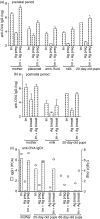Maternal-fetal interaction: preconception immunization in mice prevents neonatal sensitization induced by allergen exposure during pregnancy and breastfeeding
- PMID: 17608811
- PMCID: PMC2265981
- DOI: 10.1111/j.1365-2567.2007.02618.x
Maternal-fetal interaction: preconception immunization in mice prevents neonatal sensitization induced by allergen exposure during pregnancy and breastfeeding
Abstract
Allergen exclusion measures during pregnancy and lactation have been given consideration in studies of primary allergy prevention but complete avoidance of mother/neonatal allergen exposure has proven to be a difficult procedure. To evaluate a strategy to prevent allergen sensitization in early life in mice, we first established a neonatal model with ovalbumin sensitization through maternal allergen exposure during pregnancy or breastfeeding. The modulatory potential of preconception immunization was investigated on the neonatal development of subsequent allergic responses to maternal allergen exposure. Herein, we demonstrate that immunized mothers exposed to antigen during pregnancy or breastfeeding underwent intense vertical transmission of antibodies, including immunoglobulin G (IgG) in complex with ovalbumin and IgG1 antibody with anaphylactic function. It was further shown that maternal immunization efficiently decreased the passage of free antigens through breastfeeding and inhibited the enhanced IgE antibody response after postnatal antigen exposure. In addition, antenatal immunization decreased the antigen-specific proliferative response of immunized neonates, in parallel with profound downmodulatory effects on both the activation and differentiation of T and B cells after a non-specific stimulus and cytokine production. These findings showed that early life sensitization, subsequent to maternal allergen exposure during both the prenatal and postnatal periods, could be avoided by preventive vaccination of the mother.
Figures






References
-
- Prescott SL. Maternal allergen exposure as a risk factor for childhood asthma. Curr Allergy Asthma Report. 2006;6:75–80. - PubMed
-
- Holt PG, McMenemin C, Nelson D. Primary sensitization to inhalant allergens during infancy. Pediatr Allergy Immunol. 1990;1:3–13.
-
- Saarinen KM, Juntunen-Backman K, Jarvenpaa AL, et al. Breast-feeding and the development of cows' milk protein allergy. Adv Exp Med Biol. 2000;478:121–30. - PubMed
Publication types
MeSH terms
Substances
LinkOut - more resources
Full Text Sources
Medical

